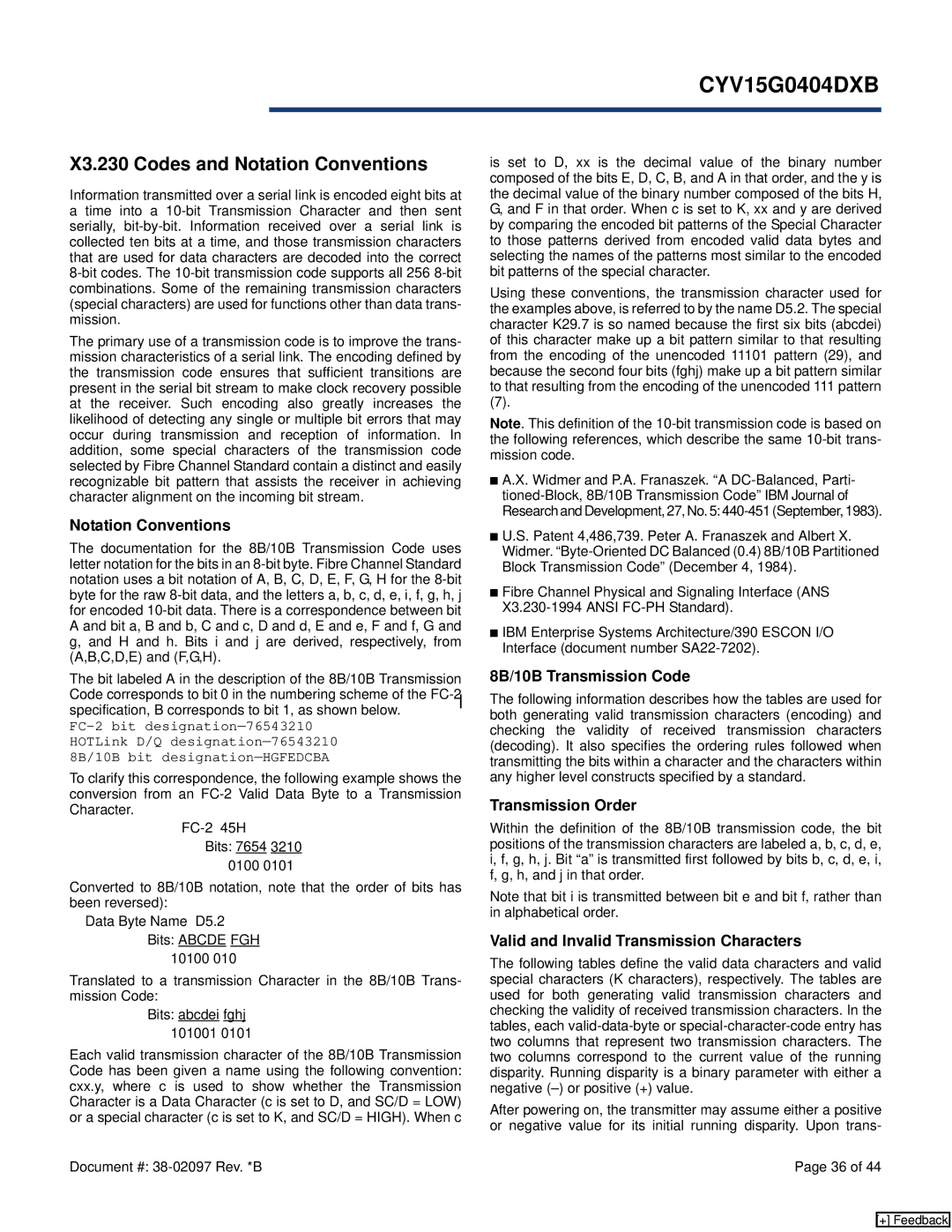
CYV15G0404DXB
X3.230 Codes and Notation Conventions
Information transmitted over a serial link is encoded eight bits at a time into a
The primary use of a transmission code is to improve the trans- mission characteristics of a serial link. The encoding defined by the transmission code ensures that sufficient transitions are present in the serial bit stream to make clock recovery possible at the receiver. Such encoding also greatly increases the likelihood of detecting any single or multiple bit errors that may occur during transmission and reception of information. In addition, some special characters of the transmission code selected by Fibre Channel Standard contain a distinct and easily recognizable bit pattern that assists the receiver in achieving character alignment on the incoming bit stream.
Notation Conventions
The documentation for the 8B/10B Transmission Code uses letter notation for the bits in an
The bit labeled A in the description of the 8B/10B Transmission Code corresponds to bit 0 in the numbering scheme of the
To clarify this correspondence, the following example shows the conversion from an
Bits: 7654 3210
0100 0101
Converted to 8B/10B notation, note that the order of bits has been reversed):
Data Byte Name D5.2
Bits: ABCDE FGH
10100 010
Translated to a transmission Character in the 8B/10B Trans- mission Code:
Bits: abcdei fghj
101001 0101
Each valid transmission character of the 8B/10B Transmission Code has been given a name using the following convention: cxx.y, where c is used to show whether the Transmission Character is a Data Character (c is set to D, and SC/D = LOW) or a special character (c is set to K, and SC/D = HIGH). When c
is set to D, xx is the decimal value of the binary number composed of the bits E, D, C, B, and A in that order, and the y is the decimal value of the binary number composed of the bits H, G, and F in that order. When c is set to K, xx and y are derived by comparing the encoded bit patterns of the Special Character to those patterns derived from encoded valid data bytes and selecting the names of the patterns most similar to the encoded bit patterns of the special character.
Using these conventions, the transmission character used for the examples above, is referred to by the name D5.2. The special character K29.7 is so named because the first six bits (abcdei) of this character make up a bit pattern similar to that resulting from the encoding of the unencoded 11101 pattern (29), and because the second four bits (fghj) make up a bit pattern similar to that resulting from the encoding of the unencoded 111 pattern
(7).
Note. This definition of the
■A.X. Widmer and P.A. Franaszek. “A
■U.S. Patent 4,486,739. Peter A. Franaszek and Albert X. Widmer.
■Fibre Channel Physical and Signaling Interface (ANS
■IBM Enterprise Systems Architecture/390 ESCON I/O Interface (document number
8B/10B Transmission Code
The following information describes how the tables are used for both generating valid transmission characters (encoding) and checking the validity of received transmission characters (decoding). It also specifies the ordering rules followed when transmitting the bits within a character and the characters within any higher level constructs specified by a standard.
Transmission Order
Within the definition of the 8B/10B transmission code, the bit positions of the transmission characters are labeled a, b, c, d, e, i, f, g, h, j. Bit “a” is transmitted first followed by bits b, c, d, e, i, f, g, h, and j in that order.
Note that bit i is transmitted between bit e and bit f, rather than in alphabetical order.
Valid and Invalid Transmission Characters
The following tables define the valid data characters and valid special characters (K characters), respectively. The tables are used for both generating valid transmission characters and checking the validity of received transmission characters. In the tables, each
After powering on, the transmitter may assume either a positive or negative value for its initial running disparity. Upon trans-
Document #: | Page 36 of 44 |
[+] Feedback
